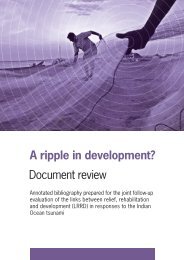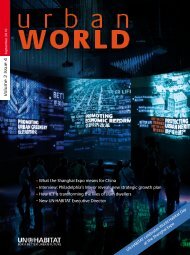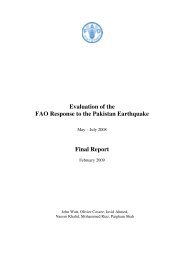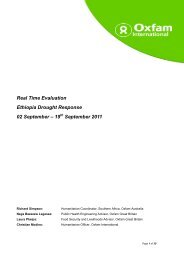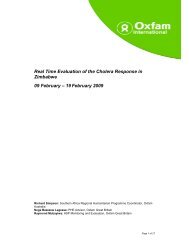Inter-Agency Real Time Evaluation of the Humanitarian ... - alnap
Inter-Agency Real Time Evaluation of the Humanitarian ... - alnap
Inter-Agency Real Time Evaluation of the Humanitarian ... - alnap
Create successful ePaper yourself
Turn your PDF publications into a flip-book with our unique Google optimized e-Paper software.
IA RTE <strong>of</strong> <strong>the</strong> humanitarian response to Pakistan’s 2010 Floods crisis<br />
‘reactive’ or ‘slow’. Some agencies characterised <strong>the</strong> international response as far too late to be<br />
considered life saving with <strong>the</strong> exception <strong>of</strong> a few areas, coming in as a second wave <strong>of</strong> support,<br />
raising questions concerning where and how <strong>the</strong> assistance was provided. As for <strong>the</strong> IDP crisis,<br />
in‐kind assistance should <strong>the</strong>refore only be provided where items are no longer available on <strong>the</strong><br />
market 25 . Several factors <strong>the</strong>refore led to <strong>the</strong> fact that <strong>the</strong> response has largely been considered<br />
to be supply driven ra<strong>the</strong>r than needs based.<br />
6.2 Response Modes<br />
65. The GoP has been clear on its role and responsibility with regards to leading <strong>the</strong> response<br />
and coordinated international efforts. Heading <strong>the</strong>se tasks was <strong>the</strong> NDMA, established in 2007.<br />
Despite vested efforts in taking <strong>the</strong> lead and coordinating <strong>the</strong> response efforts, <strong>the</strong>re have been<br />
issues concerning its role versus that <strong>of</strong> o<strong>the</strong>r national institutions, such as <strong>the</strong> Economic Affairs<br />
Division (EAD), key line departments as well as NDMA’s provincial branches, <strong>the</strong> Provincial<br />
Disaster Management Authority (PDMA) 26 . A late 2010 law, approved by <strong>the</strong> Pakistani<br />
parliament, has clarified <strong>the</strong>se issues, giving NDMA full fledged authority on matters related to<br />
disasters. PDMAs in <strong>the</strong> affected provinces are also emerging institutions and <strong>the</strong> most<br />
experienced, also with <strong>the</strong> strongest capacity, is <strong>the</strong> one in KPK due to <strong>the</strong> recurrent disasters<br />
affecting <strong>the</strong> Nor<strong>the</strong>rn regions. While most coordinating efforts at national level went through<br />
<strong>the</strong> NDMA and to some degree also PDMAs, <strong>the</strong> apparent unresolved division <strong>of</strong> labour between<br />
national institutions have seemingly also hindered a more smooth cooperation between <strong>the</strong><br />
GoP and <strong>the</strong> international community’s prime humanitarian representative, <strong>the</strong> UN.<br />
66. On its side, <strong>the</strong> UN’s performance during <strong>the</strong> initial stages did not cater for a smooth<br />
collaboration ei<strong>the</strong>r. Despite requests from <strong>the</strong> Pakistani Government’s side on limiting <strong>the</strong><br />
response efforts to four key clusters, <strong>the</strong> UN favoured, once again, to activate <strong>the</strong> ‘traditional<br />
response setup’ through eleven clusters 27 , implying also that <strong>the</strong>se were reflected in <strong>the</strong> appeal<br />
processes (i.e. <strong>the</strong> PFERP and PFRERRP’s widened scope). There are different reasons why <strong>the</strong><br />
Pakistani Government may insist on one option and <strong>the</strong> UN on ano<strong>the</strong>r. On one side, <strong>the</strong><br />
Pakistan Government, keen on solving internal affairs fast, favoured <strong>the</strong> more focused and<br />
short‐lived option. On <strong>the</strong> o<strong>the</strong>r side, <strong>the</strong> UN, driven by a more rights based approach, favoured<br />
<strong>the</strong> inclusive and all‐encompassing scope.<br />
67. The RTE found that while all clusters indisputably have made contributions to ease<br />
suffering <strong>of</strong> <strong>the</strong> affected populations, many interviewees argued that <strong>the</strong> large cluster setup was<br />
too cumbersome and took away focus from <strong>the</strong> response (see part 7 on Coordination and<br />
25<br />
See recommendation 7 in IA‐RTE <strong>of</strong> <strong>Humanitarian</strong> Response to 2009 Displacement Crisis, DARA, 2010<br />
26 th<br />
The 8 Amendment to Pakistan’s constitution passed in April, 2010 devolves more autonomy to <strong>the</strong> Provincial level<br />
than <strong>the</strong> Federal level. However, <strong>the</strong> Federal Government still leads on international development and humanitarian<br />
assistance and its allocation to <strong>the</strong> provinces.<br />
27<br />
The 2007 IASC RTE pointed to <strong>the</strong> same issue where NDMA preferred four4 clusters and not <strong>the</strong> 12 that were finally<br />
setup as a response to <strong>the</strong> emergencies following <strong>the</strong> floods and cyclone Yemyin earlier that same year.<br />
Riccardo Polastro, Aatika Nagrah, Nicolai Steen and Farwa Zafar<br />
34







